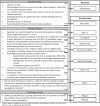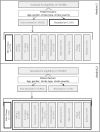Exploring threats to generalisability in a large international rehabilitation trial (AVERT)
- PMID: 26283667
- PMCID: PMC4550737
- DOI: 10.1136/bmjopen-2015-008378
Exploring threats to generalisability in a large international rehabilitation trial (AVERT)
Abstract
Objective: The purpose of this paper is to examine potential threats to generalisability of the results of a multicentre randomised controlled trial using data from A Very Early Rehabilitation Trial (AVERT).
Design: AVERT is a prospective, parallel group, assessor-blinded randomised clinical trial. This paper presents data assessing the generalisability of AVERT.
Setting: Acute stroke units at 44 hospitals in 8 countries.
Participants: The first 20,000 patients screened for AVERT, of whom 1158 were recruited and randomised.
Model: We use the Proximal Similarity Model, which considers the person, place, and setting and practice, as a framework for considering generalisability. As well as comparing the recruited patients with the target population, we also performed an exploratory analysis of the demographic, clinical, site and process factors associated with recruitment.
Results: The demographics and stroke characteristics of the included patients in the trial were broadly similar to population-based norms, with the exception that AVERT had a greater proportion of men. The most common reason for non-recruitment was late arrival to hospital (ie, >24 h). Overall, being older and female reduced the odds of recruitment to the trial. More women than men were excluded for most of the reasons, including refusal. The odds of exclusion due to early deterioration were particularly high for those with severe stroke (OR=10.4, p<0.001, 95% CI 9.27 to 11.65).
Conclusions: A model which explores person, place, and setting and practice factors can provide important information about the external validity of a trial, and could be applied to other clinical trials.
Trial registration number: Australian New Zealand Clinical Trials Registry (ACTRN12606000185561) and Clinicaltrials.gov (NCT01846247).
Keywords: Generalisability; Proximal Similarity Model; Randomised Control Trial; Rehabilitation.
Published by the BMJ Publishing Group Limited. For permission to use (where not already granted under a licence) please go to http://group.bmj.com/group/rights-licensing/permissions.
Figures



References
-
- Higgins JP, Green S. Cochrane handbook for systematic reviews of interventions. West Sussex, England: The Cochrane Collaboration, 2008.
Publication types
MeSH terms
Associated data
Grants and funding
LinkOut - more resources
Full Text Sources
Other Literature Sources
Medical
Research Materials
